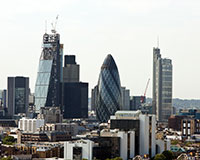When we talk about foreign interest in London, the first thing that springs to mind is investment. But what about the occupiers? The world is getting smaller, people more mobile and the UK capital’s strong commercial market ?and impressive, growing tech scene is attracting more international players.
In short, London is now ?more than just a place to ?splash the cash. Overseas companies are moving in. But the occupiers and investors are not one and the same. Figures from Cushman & Wakefield show that while Asia and the Middle East are two of the most active investor regions into the city after domestic funds, accounting for 28% and 14% of all investment into the capital, they are nowhere near the biggest overseas occupiers. So who is?
Where are they from?
Discounting UK companies – which accounted for 62% of take-up on large transactions in the capital over the last 12 months – the US has been the main source of leasing transactions, accounting for almost 30% of take-up. This equates to more than 2m sq ft in London since Q1 2013. Europe trails at 7.2%, followed by Asia – coming in low at 1.9% or around 150,000 sq ft – and Canada at 1.4%.
Occupiers by sector
Additional research reveals that media and technology occupiers have dominated leasing activity over the last year – particularly towards the end of 2013. Media accounted for 18.9% of take-up in 2013 and already stands at 9.9% in Q1 of 2014. Add this to the figures for telecoms and technology (17.5% and 16.2%) and the overall figure hits 36% take-up for 2013 and 26% for Q1 2014. Professional services and banking and financial are the only pretenders to the ?TMT throne with 25.8% and 22.8% of take-up respectively in Q1 2014.
Can TMT growth continue?
There have been questions over the sustainability of office take-up within the TMT sector as there are those who argue that tech companies and start-ups require little space to operate as a business. With these firms growing at exponential rates, the knock-on effect of the new Google HQ and demand from US tech firms like RocketSpace, media and technology remains the largest sector in terms of active and future demand, according to research. Banking and financial follow and the big gaps then start to appear as public and government, and professional and business follow. At the other end of the spectrum, demand for insurance and manufacturing pales in comparison.
View from the US
With almost a third of take-up over the last year accounted for by US corporates, and a wave of US tech firms increasingly eyeing London, it’s the Americans we need to keep a close eye on. So what exactly are they looking for in their ultimate UK landing pads?
Duncan Logan, chief executive of San Francisco based start-up RocketSpace
“We’re looking for 100,000 sq ft in London. It’s hard to find. We would pay a premium to be central if we could find the right space. We are interested in King’s Cross, Farringdon. Maybe Old Street. What we will not do is move further south. There is an ace that Britain has up its sleeve – the language. Just by being English-speaking, the UK is at the top of the list for US firms looking to expand overseas.”
Mark Bartels, chief executive of US discovery engine StumbleUpon
“We have looked at Paris for a European expansion in the past but probably wouldn’t ?do so again. Having a common language is a huge advantage. Being in London would be great as there is such a high proportion of talent there. We would look to go where that talent is. So as central as possible, within reason, in terms of financials.”
Jim Patterson, chief executive of US-based app Cotap
“We would look seriously at expanding into offices in London though Shoreditch is maybe a bit too out of the way. King’s Cross might be better.”
This data forms part of EG’s latest Global edition. To download the full digital edition, go to the EG app in the App Store or visit the Estates Gazette website.
Emily.Wright@estatesgazette.com











